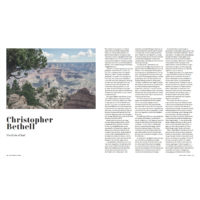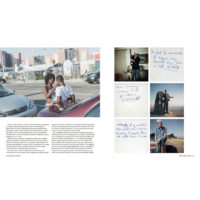-
Christopher Bethell ~ The Duke of Earl
Splash & Grab, Issue 3
The creation of a genogram is a method used in therapy to better understand the behavioural and hereditary patterns of a patient’s family that have emerged or been replicated over time. A genogram differs from a family tree because it utilises symbols that represent, for example, miscarriage, marriage, separation and illness, to allow the patient to develop a visual understanding of their family intergenerationally.
Last year I was encouraged to draw my own genogram. On the maternal side this was easy and I connected names and symbols effortlessly. When I reached my paternal grandfather, his name sat on the page like a full stop, virtually the only information I could offer about him. Through his choosing we have never met, although he lives just around the corner from my mother. The visualisation of my grandfather as a dot on paper abruptly shed light on countless unanswered questions about my identity and the behaviour of my family in a way I hadn’t considered before.
Christopher Bethell’s grandfather, Joseph “Joey” O’Donnell was an American citizen who died in the US when Bethell was a baby. Having been born in the UK, Bethell never met Joey. For 22 years, he conjured stories of his grandfather based on the photographs he had seen and the vague family stories he had heard, romanticising both Joey’s life and America. He planned to travel to the US to visit all the places Joey had lived and explore this ideology of family history and identity that he had convinced himself of.
Bethell had believed Joey to be a jazz musician before starting a family, who he subsequently left to rekindle his passion for jazz. He thought that when he was unsuccessful, he moved to Las Vegas and became consumed by the lifestyle, which resulted in an early death. At age 22 Bethell sat down with his grandmother to discuss her memories of Joey and America, but she explained that this version of events he had believed all his life were largely untrue.
If my grandfather suddenly became a full stop in my imagination, the realisation that Joey’s life was not the fabricated narrative Bethell had created became an open book of confusion and disorientation in his. As he states in his introduction, ‘This revelation complicated things; it shook up my understanding of my identity and the country I romanticised, and also distanced me from Joey.” It took four years before he was ready to make his trip to America, but this readiness saturates the photographs he made there wholeheartedly, like words that can’t leave the mouth quick enough.
The Duke of Earl is presented in four chapters, each one beginning with portraits of Joey that represent different periods of his life, Bethell’s visual starting block for the person he had believed his grandfather to be. We see Joey standing powerful and heroic with a gun in his hand, the photograph acting as a mirror projecting an ideal self. Flip the photo over however (fittingly printed on Kodak paper), and Joey’s handwritten notes begin to amplify the duality of truth and fiction, and the theme of confusion that permeates through the images like a slow ache. In another picture, Joey is standing confidently atop a monument, the American landscape far below him, but his writing overleaf reads, ‘One wrong move and I’d go 50,000 feet down.’
This forms the basis of the space between fantasy and actuality that Bethell navigates with his own visual language, which is cinematic yet familiar, and unquestionably genreless. Both his concoction of events and his process of coming to terms with reality are weaved within the pictures poignantly, so that the viewer experiences similar disorientation to his own.
We might think of this as a swaying between two points until balance or truthfulness is found. In March 2015, Tim Robertson made his speech Art Not Crime at The Koestler Trust, asserting, ‘‘…all art is about a relationship between containment and escape, and it’s the tension between those, it’s the toing and froing, the dynamic between those that generates creativity, and that leads to both personal and social growth and gets us closer to truthfulness…’
For most of his life, Bethell’s idea of escape was his belief in an identity constructed falsely, and suddenly it was this that became his containment. Only when he attempted to visually articulate his confusion and the conflicts he discovered in establishing his own identity within his family history, could his search for the truth become his escape.
He achieves this in part through an abundance of contradictory signs, symbols and handwritten words that he captured in almost every picture. His ideals of Joey encompassing strength and heroism encouraged him to believe these traits could feed confidently into his own destiny. When Joey’s reputation wilted, Bethell had to start again, so he represented his search for direction in signs, narratives, and signals, but their opposing nature only told him there was no right way regardless, only his own way.
In attempting to mark out this path, there’s a wealth of implied movement in the book, whether literal or emotional. Through all of this activity there are many moments of solitude and stillness that punctuate this flow, replicating intakes of breath or time to observe. One man leans against a wall at the bottom of an elevator, his head horizontal either in exhaustion or intoxication. The presence of such characters and moments create certainty and uncertainty, again, a fluctuation between two points and the sensation that everything could swing the other way momentarily.
This extends through the recurrent representation of animals. Most prominent is the presence of dogs being transported by their owners in vehicles, their expressions and demeanours familiar and present, entirely anthropomorphised. They speak not only of a sense of belonging, but of a strange ability to communicate, not wholly, somewhere between just out of reach and a lifetime away. In discussing why people photograph dogs, Robert Adams states, “…what sustained the artists’ affection for dogs was above all the animals’ enlivening sense of possibility… ‘A dog loves life as the young love it,’ Henry Beetle Hough wrote, ‘always and always.’”
When I asked Bethell about the presence of animals, he also cited possibility, hope and freedom as their purpose. In this sense these images become a nod to someone else’s past and his own future, an awareness of it all and his own secure place within it. A Siamese cat twinned by its shadow stares from a car window, seemingly in the driving seat as if it could take itself anywhere. A small herd of bison wander together amidst a vast American landscape, and a boy lies amongst two sleeping pigs, with them but not of them.
If the inclusion of animals creates a sense of belonging, the presence of strangers delicately magnifies the absence of Joey throughout Bethell’s life. His ability to depict the emotions he wanted to express through the strangers he encountered, and make them familiar, gives him boldness and a right of passage to tell his story unencumbered and without fear. It has been waiting to be told for a long time, and the photographs are its voice.
Eventually, after an emotional struggle to find Joey’s grave, Bethell literally uncovers the landmark with his bare hands. The story of this is relayed beautifully in the epilogue, paced like a racing pulse visible under the skin. Through the photographs we see his journey as a pendulum that swayed vigorously between fiction and reality, or containment and escape, eventually resting in subtle vibration at Joey’s grave.
The more time I’ve spent with The Duke of Earl, the more I’ve visualised it as its own genogram. The photographs constitute symbols, characters and themes, created in a short space of time that document, connect and demystify layers of history, and transcend time. The result is an intricate temporal condition, as if past, present and future were transparent images viewable one over the other.
On asking Bethell if the work had made him change his perspective of family in the way my own genogram had, he said that it had matured him, something that’s analogous to the work itself. As Ryuji Miyamoto stated in The Silence of Photographs, “…it is through the photograph that we must look upon those very things whose true nature makes them absolutely impossible to be seen any other way.” Beginning as a story that he told himself as a child, The Duke of Earl has culminated in complex layers of sophisticated photographic narrative, which Bethell has used to make sense of his family history and his own identity in a way that only this medium permits. In turn this allows fantasy and reality to coexist within Bethell’s own sense of peace.
-

-
